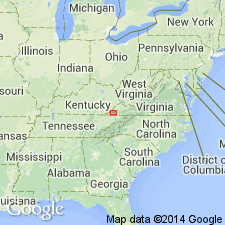
- Usage in publication:
-
- Little Stone Gap Member*
- Modifications:
-
- Named
- Dominant lithology:
-
- Limestone
- Shale
- Mudstone
- AAPG geologic province:
-
- Appalachian basin
Summary:
Named Little Stone Gap Member of the Hinton Formation. Composed of shale, mudstone, and limestone. About 44.5 ft thick at type section. Underlain by middle red member of the Hinton Formation; overlain by the Princeton Sandstone. Age is Mississippian (late Chesterian).
Source: GNU records (USGS DDS-6; Reston GNULEX).
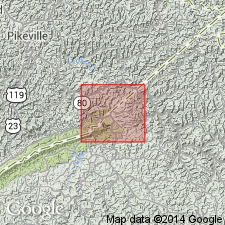
- Usage in publication:
-
- Little Stone Gap Member*
- Modifications:
-
- Revised
- AAPG geologic province:
-
- Appalachian basin
Summary:
Little Stone Gap Member of the Hinton Formation adopted by the U.S. Geological Survey for use in KY as the Little Stone Gap Member of the Pennington Formation.
Source: GNU records (USGS DDS-6; Reston GNULEX).
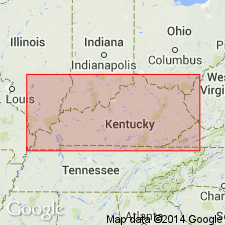
- Usage in publication:
-
- Little Stone Gap Member
- Modifications:
-
- Revised
- AAPG geologic province:
-
- Appalachian basin
Summary:
Pennington Group in eastern KY is divided into (ascending) Bluefield Formation, Hinton Formation, Princeton Sandstone, and Bluestone Formation. Stony Gap Sandstone Member occurs at the base of the Hinton, while Little Stone Gap Member occurs near the top of the Hinton. The Little Stone Gap is an argillaceous limestone or calcareous shale, previously called Avis Limestone. Has been mistakenly referred to upon occasion as the "Little Lime," which is actually the Poppin Rock Member of the Slade Formation, lower in the section. Age is Late Mississippian.
Source: GNU records (USGS DDS-6; Reston GNULEX).
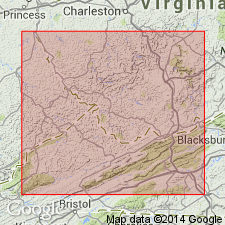
- Usage in publication:
-
- Little Stone Gap Member*
- Modifications:
-
- Overview
- AAPG geologic province:
-
- Appalachian basin
Summary:
Based on the ORTHOTETES SUBGLOBOSUS-MARTINIA CONTRACTA Assemblage Zone, the Little Stone Gap Member of the Hinton Formation correlates with the middle and upper parts of the Fayetteville Shale in the Ozark region and with the top of the Glen Dean Limestone to the base of the Menard Limestone in the "type" Chesterian in the Illinois basin.
Source: GNU records (USGS DDS-6; Reston GNULEX).
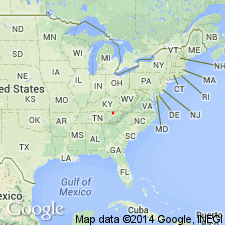
- Usage in publication:
-
- Little Stone Gap Member*
- Modifications:
-
- Overview
- AAPG geologic province:
-
- Appalachian basin
Summary:
Lower part of upper member of Pennington Formation, just below tongue of Pinnacle Overlook Member of Lee Formation, is approximately equivalent to Little Stone Gap Member of Hinton Formation elsewhere in Appalachian basin.
Source: GNU records (USGS DDS-6; Reston GNULEX).
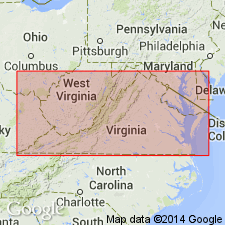
- Usage in publication:
-
- Little Stone Gap Member
- Modifications:
-
- Areal extent
- AAPG geologic province:
-
- Appalachian basin
Summary:
Hinton Formation is divided into seven distinct lithologic members in the report area: the Stony Gap Sandstone Member at the base, the middle red member, the Little Stone Gap Member, the middle shale member of Englund (1968), the Tallery Sandstone Member, the Pratter Shale Member, and the upper shale member of Englund (1968). The Little Stone Gap Member is a medium-gray, abundantly fossiliferous, argillaceous, highly calcareous shale and micritic limestone. The limestone averages 30 ft in thickness. The Little Stone Gap is present throughout the area of the report. However, the limestone grades laterally into calcareous shale and is truncated locally by the Tallery Sandstone Member in western Buchanan, Dickenson, and Wise Cos. In northwestern Buchanan Co. and Mingo Co., WV, it is composed of grayish-red, brown, and gray, calcareous shale and limestone. Age is Late Mississippian (Chesterian).
Source: GNU records (USGS DDS-6; Reston GNULEX).
For more information, please contact Nancy Stamm, Geologic Names Committee Secretary.
Asterisk (*) indicates published by U.S. Geological Survey authors.
"No current usage" (†) implies that a name has been abandoned or has fallen into disuse. Former usage and, if known, replacement name given in parentheses ( ).
Slash (/) indicates name conflicts with nomenclatural guidelines (CSN, 1933; ACSN, 1961, 1970; NACSN, 1983, 2005, 2021). May be explained within brackets ([ ]).

